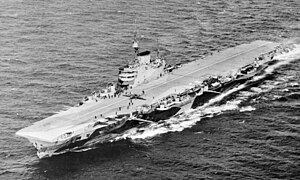HMS Indefatigable (R10)

Aerial view of Indefatigable at sea, 7 November 1944
|
|
| History | |
|---|---|
|
|
|
| Name: | HMS Indefatigable |
| Builder: | John Brown & Co., Clydebank, Scotland |
| Laid down: | 3 November 1939 |
| Launched: | 8 December 1942 |
| Completed: | 3 May 1944 |
| Commissioned: | 8 December 1943 |
| Recommissioned: | 28 May 1950 |
| Decommissioned: | December 1946 |
| Identification: | Pennant number: 10 |
| Honours and awards: |
Palembang 1945, Okinawa 1945, Japan 1945 |
| Fate: | Sold for scrap, September 1956 |
| General characteristics | |
| Class and type: | Implacable-class aircraft carrier |
| Displacement: | 32,110 long tons (32,630 t) (deep load) |
| Length: | |
| Beam: | 95 ft 9 in (29.2 m) |
| Draught: | 29 ft 4 in (8.9 m) (deep load) |
| Installed power: |
|
| Propulsion: |
|
| Speed: | 32.5 knots (60.2 km/h; 37.4 mph) |
| Range: | 6,900 nmi (12,800 km; 7,900 mi) at 20 knots (37 km/h; 23 mph) |
| Complement: | 2,300 (1945) |
| Sensors and processing systems: |
|
| Armament: |
|
| Armour: |
|
| Aircraft carried: | 81 |
| Aviation facilities: | 1 catapult |
HMS Indefatigable was an Implacable-class aircraft carrier built for the Royal Navy (RN) during World War II. She was completed in 1944, and her aircraft made several attacks that year against the German battleship Tirpitz, inflicting only light damage; they also raided targets in Norway. The ship was transferred to the British Pacific Fleet (BPF) at the end of the year and attacked Japanese-controlled oil refineries in Sumatra in January 1945 before joining the American forces in March as they prepared to invade the island of Okinawa in Operation Iceberg. Indefatigable and the BPF joined the Americans in attacking the Japanese Home Islands in July and August. Following the end of hostilities she visited ports in Australia, New Zealand and South Africa.
After returning to the UK in early 1946, Indefatigable was modified for transport duties, and ferried troops and civilians for the rest of the year before she was reduced to reserve. She was recommissioned in 1950 as a training ship for service with the Home Fleet Training Squadron, participating in exercises and making several port visits overseas. The Board of Admiralty decided that she was redundant in early 1954 and decommissioned her later that year. Indefatigable was sold for scrap the following year.
The Implacable class were ordered under the 1938 Naval Programme by the Chamberlain government as part of the general rearmament begun in response to the rise of Nazi Germany and Fascist Italy. The design originated as an improved version of the Illustrious-class aircraft carriers and was intended to be 2 knots (3.7 km/h; 2.3 mph) faster and carry an additional dozen aircraft over the 30-knot (56 km/h; 35 mph) speed and 36 aircraft of the earlier ships. To remain within the 23,000 long tons (23,000 t) limit allowed by the Second London Naval Treaty, these improvements could only be made by reducing armour protection.Indefatigable was 766 feet 6 inches (233.6 m) long overall and 730 feet (222.5 m) at the waterline. Her beam was 95 feet 9 inches (29.2 m) at the waterline, and she had a draught of 29 feet 4 inches (8.9 m) at deep load. The Implacable-class ships were significantly overweight and displaced 32,110 long tons (32,630 t) at deep load. The ships had metacentric heights of 4.06 feet (1.2 m) at light load and 6.91 feet (2.1 m) at deep load as completed.Indefatigable's complement was approximately 2,300 officers and enlisted men in 1945.
...
Wikipedia
